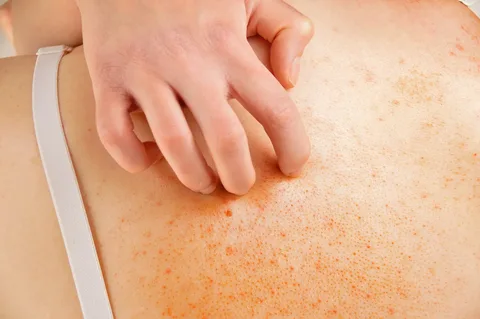- 27 February 2024
- 195
Beyond the Rash: Recognizing Signs of a Problem

Introduction
Skin rashes are often dismissed as minor inconveniences, but they can sometimes signify more significant underlying issues. It’s crucial to recognize when a rash is more than just a temporary irritation and understand the potential implications it may have for your health. In this comprehensive guide, we’ll delve into the various types of rashes, their causes, and when they might indicate a more serious problem. Explore more about (Risk and Solution of Nighttime Itching)
Understanding Different Types of Rashes
1. Contact Dermatitis
Contact dermatitis is one of the most common types of rashes and occurs when the skin comes into contact with an irritant or allergen. It typically manifests as red, itchy, and sometimes blistered skin. Common triggers include certain cosmetics, soaps, plants like poison ivy, and certain metals.
2. Atopic Dermatitis (Eczema)
Atopic dermatitis, commonly known as eczema, is a chronic skin condition characterized by inflamed, itchy patches of skin. It often develops in childhood and may persist into adulthood. While the exact cause is unknown, it’s believed to involve a combination of genetic and environmental factors.
3. Psoriasis
Psoriasis is a chronic autoimmune condition that speeds up the growth cycle of skin cells, leading to the formation of thick, red patches with silvery scales. These patches can be itchy and painful and may occur anywhere on the body, including the scalp, elbows, knees, and lower back.
4. Heat Rash
Heat rash, also known as prickly heat, occurs when sweat becomes trapped in the sweat ducts, leading to inflammation and the development of small red bumps or blisters. It commonly occurs in hot, humid weather and typically resolves on its own once the skin cools down.

5. Rosacea
Rosacea is a chronic inflammatory skin condition that primarily affects the face, causing redness, visible blood vessels, and sometimes, small, pus-filled bumps. It often begins with episodes of flushing or blushing and may progressively worsen over time if left untreated.
When to Seek Medical Attention
While many rashes are harmless and resolve on their own, some may indicate an underlying medical problem that requires prompt attention. It’s essential to consult a healthcare professional if you experience any of the following:
1. Severe Pain or Discomfort
If your rash is accompanied by severe pain or discomfort, it may be a sign of a more serious condition such as an infection or allergic reaction.
2. Rapid Spreading or Worsening
If your rash spreads rapidly or worsens despite home treatment, it’s advisable to seek medical advice as it could indicate an underlying infection or systemic illness.
3. Fever or Other Systemic Symptoms
Fever, chills, fatigue, and other systemic symptoms accompanying a rash may suggest a more serious underlying condition that requires medical evaluation.
4. Difficulty Breathing or Swallowing
Rashes accompanied by difficulty breathing, swallowing, or swelling of the face or throat may indicate a severe allergic reaction (anaphylaxis) and require immediate medical attention.
5. Rash in a Newborn or Infant
Rashes in newborns or infants should always be evaluated by a pediatrician, as they may be a sign of a more serious condition such as an infection or allergic reaction.

Prevention and Management
While some rashes are unavoidable, there are steps you can take to reduce your risk and manage symptoms:
1. Avoid Triggers
Identify and avoid triggers that exacerbate your rash, whether they be certain foods, skincare products, or environmental factors.
2. Practice Good Skincare
Maintain good skincare habits, including keeping your skin clean and moisturized, using gentle products, and avoiding harsh chemicals and fragrances.
3. Seek Medical Advice
If you’re unsure about the cause of your rash or how to manage it, don’t hesitate to seek medical advice. A healthcare professional can provide an accurate diagnosis and recommend appropriate treatment.
4. Follow Treatment Plans
If you’re diagnosed with a chronic skin condition like eczema or psoriasis, follow your treatment plan as prescribed by your healthcare provider to manage symptoms and prevent flare-ups.
5. Stay Informed
Stay informed about common skin conditions and their symptoms, so you can recognize when to seek medical attention and when home treatment is sufficient.
Common Skin Rashes
| Type of Rash | Symptoms | Causes | Treatment |
|---|---|---|---|
| Contact Dermatitis | Redness, itching, blistering | Irritants/allergens such as cosmetics, soaps, plants | Avoiding triggers, topical corticosteroids |
| Atopic Dermatitis | Inflammation, itching, dry skin | Genetic, environmental factors | Moisturizers, topical corticosteroids, antihistamines |
| Psoriasis | Red, scaly patches | Autoimmune, genetic factors | Topical treatments, phototherapy, systemic medications |
| Heat Rash | Red bumps, blisters | Blocked sweat ducts | Cool environment, keeping skin dry |
| Rosacea | Facial redness, visible blood vessels | Unknown, may involve genetics, environmental triggers | Topical medications, oral antibiotics, laser therapy |
Conclusion
While most rashes are harmless and resolve on their own, it’s essential to recognize when a rash may signify a more significant underlying issue. By understanding the different types of rashes, their causes, and when to seek medical attention, you can take proactive steps to protect your skin health and overall well-being.
Remember, if you’re ever unsure about a rash or experiencing concerning symptoms, don’t hesitate to consult a healthcare professional for guidance and support.

